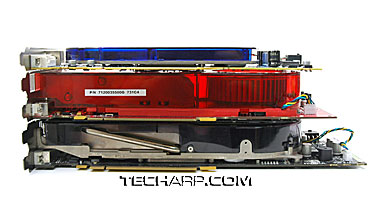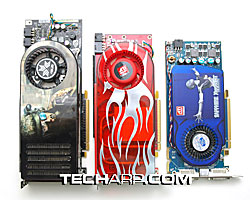Introduction
Launched on May 14, 2007, the Radeon HD 2900 XT is the first of ATI's new HD 2000 series of desktop graphics cards. Based on the long-awaited (and long-delayed) R600 VPU, this makes it the first ATI desktop graphics to support DirectX 10. Like its rivals from NVIDIA, it features a massively-parallel unified architecture with general-purpose stream processors, instead of dedicated pixel and vertex shaders.
Compared to its predecessors, it is a massive chip in more ways than one. Packed inside the large chip are 720 million transistors. That's almost twice as many transistors as its predecessors. In fact, it has 39 million more transistors than the NVIDIA G80 GPU used in the GeForce 8800 GTX and GeForce 8800 Ultra. With that many transistors under the hood, the R600 is not only a big chip, but it is also a hot one.
To help keep the size and thermal output of the chip down, the R600 was fabricated on the TSMC 80 nm HS (High Speed) process. Although the smaller and newer 65 nm process was available, ATI chose the 80 nm process because it was a more mature process and allowed them to ramp up the clock speed.
Now, let's take a look at how the Radeon HD 2900 XT compares against its predecessors in this comparison table of ATI's top-of-the-line graphics cards of the past and present.
Radeon HD 2900 XT |
Radeon X1950 XTX |
Radeon X1900 XT |
Radeon X1800 XT |
|
Architecture |
R600 |
R580+ |
R580 |
R520 |
Manufacturing Process |
0.08 Micron |
0.09 Micron |
0.09 Micron |
0.09 Micron |
Transistor Count |
720 Million |
384 Million |
384 Million |
321 Million |
DirectX Support |
10 |
9.0c |
9.0c |
9.0c |
Interface |
PCI Express x16 |
PCI Express x16 |
PCI Express x16 |
PCI Express x16 |
Stream
Processors |
320 |
- |
- |
- |
Vertex
Shaders |
- |
8 |
8 |
8 |
Vertex
Shader Version |
4.0 |
3.0 |
3.0 |
3.0 |
Pixel
Shaders |
- |
48 |
48 |
16 |
Pixel
Shader Version |
4.0 |
3.0 |
3.0 |
3.0 |
ROPs |
16 |
16 |
16 |
16 |
Core
Speed |
742 MHz |
650 MHz |
625 MHz |
625 MHz |
Fill
Rate |
11,872 MTexels/s |
10,400 MTexels/s |
10,000 MTexels/s |
10,000 MTexels/s |
Memory
Bus Width |
512-bits |
256-bits |
256-bits |
256-bits |
Memory
Type |
GDDR3 |
GDDR3 |
GDDR3 |
GDDR3 |
Memory
Speed |
825 MHz |
1000 MHz |
725 MHz |
750 MHz |
Memory
Bandwidth |
105.60 GB/s |
64.00 GB/s |
46.40 GB/s |
48.00 GB/s |
For all those extra transistors, you would have expected the new Radeon HD 2900 XT to offer a tremendous fill rate advantage over its predecessors but as you can see, that's not the case. The Radeon HD 2900 XT only has a relatively small 14% advantage in texture fill rate over the Radeon X1950 XTX.
Its biggest performance advantage (at least in specifications) lay not in its processing brawn but rather in its memory bandwidth. Thanks to the super-wide 512-bit memory bus, it boasts an incredible memory bandwidth of 105.6 GB/s. That is 65% more memory bandwidth than the Radeon X1950 XTX and over 22% more than the GeForce 8800 GTX. It even edges out the top NVIDIA card, the GeForce 8800 Ultra in this respect.
Size Comparison
To give you an idea of how big it is, we compared it against an ASUS EN8800GTX graphics card and a Sapphire Radeon X1950 GT graphics card. As you can see, both the Radeon HD 2900 XT and the ASUS EN8800GTX are double-slot cards, with twice the thickness of the usual single-slot cards, represented by the blue Sapphire Radeon X1950 GT card.
Surprisingly, the Radeon HD 2900 XT is much shorter than the ASUS EN8800GTX although both have coolers of the same dimensions. This is contrary to what rumour-mongers claimed when the Radeon HD 2900 XT was still in development. Nonetheless, this is still a large card that will not fit well in smaller PC chassis.







 Add to Reddit
Add to Reddit


